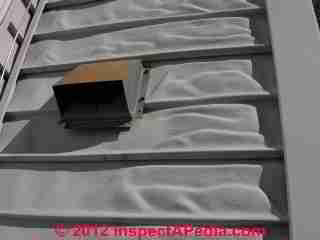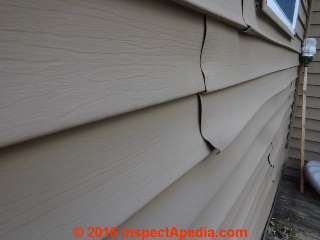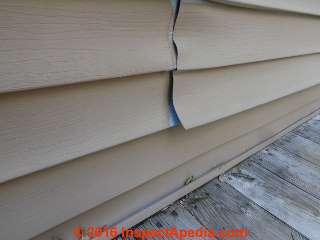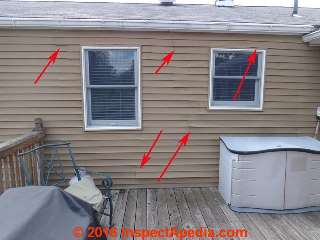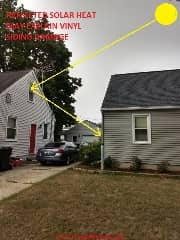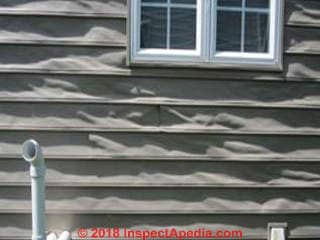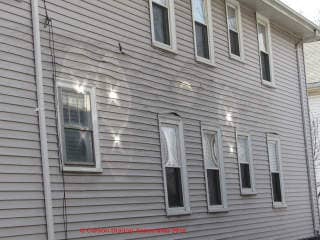 Sun or Reflected Heat as Cause of Buckled Vinyl Siding
Sun or Reflected Heat as Cause of Buckled Vinyl Siding
- POST a QUESTION or COMMENT about Vinyl Siding on Buildings, Installation, Inspection Methods, Defects, Diagnosis & Repair
Heat & reflected sunlight as causes of vinyl siding damage:
Heat from intense sunlight or from reflected sun and heat from nearby windows or other surfaces can cause buckled, rippled, bent, deformed, loose, or un-clipped vinyl siding. This article documents those effects, conditions, and apparent causes.
Page top photo: vinyl siding damaged by reflected heat from windows on an opposing building, courtesy Carson Dunlop Associates, a Toronto home inspection, report-writing tool & education company.
This article series discusses all of the known causes of buckled, loose, cracked or otherwise damaged vinyl siding.
Rippled or loose vinyl siding may be more than just a cosmetic worry, and may indicate structural defects, building movement, leaks, or even heat or fire hazards. Our page top photo shows wrinkled vinyl siding - often caused by heat exposure but in this case the extent, location, pattern and size of the damage made us suspect that there was another cause, as we explain below.
InspectAPedia tolerates no conflicts of interest. We have no relationship with advertisers, products, or services discussed at this website.
Vinyl Siding Deformation Reflected Sunlight & Heat from Nearby Surfaces,
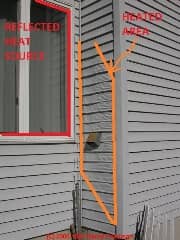 Buckling or warping vinyl siding, caused by a variety of effects including radiant heat damage has been discussed for more than forty years and continues today. (Isner 1978, Summer 1983, Hart 2011 and Walkinshaw 2012).
Buckling or warping vinyl siding, caused by a variety of effects including radiant heat damage has been discussed for more than forty years and continues today. (Isner 1978, Summer 1983, Hart 2011 and Walkinshaw 2012).
Yet some professed experts assert that vinyl siding does not deform, buckle, or "oil can" in response to heat from sunlight or reflected sunlight. Sometimes they are mistaken.
Here we give examples of vinyl siding and trim damaged by reflected heat and we illustrate steps in diagnosing reflected heat damage (distinguishing it from other causes of siding damage), usually from sunlight and nearby windows, as a cause of buckled, warped, or rippled vinyl siding.
Originally we thought the vinyl siding product at shown in the photos shown here was defective, or that it may have been damaged by a solvent. But it is difficult to imagine that defective siding would have been cut and installed with the rippled effects in such a regular pattern. Now we know it was almost certainly the effect of radiant heat or reflected heat.
[Click to enlarge any image]
- Notice that at the left side of the chimney chase there is a straight, small vertical ripple extending through the siding sections
- Notice that that vertical ripple begins about five siding segments below the fireplace insert air intake vent (one reader mistook that air intake for a clothes dryer vent - it is not)
- Notice that at the right side of the chimney chase where siding segments are quite rippled in a regular pattern, the deformation begins at the very first siding course and extends upwards at least five siding segments above the fireplace vent
- Notice that both of these siding deformation patterns vary monotonically in degree of deformation, from slight at the bottom onset, through most severe, and then again back to slight at the highest location of deformation.
- These deformation patterns and the location of them should suggest possible causes such as a spill or possibly a heat leak from the fireplace enclosed by this chimney chase
Reflected heat and sunlight: drawing lines - as we have done on the photo - marking the position of a nearby window and lines that mark the limits of the buckled siding can provide a very strong argument for reflected heat from sunlight from the nearby window.
One would confirm that hypothesis by relating the window, the damage area, and the position of the sun on these building areas, especially during seasons of stronger sunlight.
Buckled Vinyl Siding Suspected Due to Sunlight: Pennsylvania
Reader comment: Buckled siding attributed to heat reflected off a deck
... the warped siding that might be related to the orientation of the wooden deck relative to the siding. The siding in question faces directly east. and am located just north of Philadelphia. This time of year, the morning sun hits the deck and siding.
You can see the warping on the siding with the deck boards perpendicular to the siding whereas, the other siding has no warpage and the boards are parallel to the house.
I really believe it has something to do with the sun's rays reflecting off the deck Other sides of the house are ok. - Schmitty, 2016/06/22 by page bottom comment & private email
Oddly the worst buckling appears to occur at the siding course end-laps between sections. From additional correspondence among the building owner, editor, and Alan Carson we note the following:
- The buckling vinyl siding is worst at end laps of siding on the most-sunny side of the home.
- The homeowner who painted the siding pushed paint under and between the lapped siding ends, wetting the back of the siding in those areas;
- It is possible that a combination of paint chemistry (solvents affecting siding), thinness of the siding, and effects of heat from sunlight resulted in the buckling shown in these photos.
20 Variables Explain Why Buckled Siding Appears on One Building & Not Others in the Same Neighborhood
 Some readers have asked why siding on their home appears to be damaged by heat or reflected heat or direct sun while other similar homes in the same neighborhood suffered no damage. Here we collect possible explanations of that variance.
Some readers have asked why siding on their home appears to be damaged by heat or reflected heat or direct sun while other similar homes in the same neighborhood suffered no damage. Here we collect possible explanations of that variance.
Illustration: Boral Building Products' Foundry Specialty Siding produces this foam-backed vinyl siding. - Boral Building Products, 29797 Beck Rd., Wixom MI 48393, Tel: 800-771-44867, retrieved 2018/08/19, original source: www.foundrysiding.com,
- Ambient temperatures: the temperature of the outdoor environment to which the siding is exposed determine a base environment to which additional heat from radiated or reflected sources must be added when understanding why vinyl siding deforms.
- Architectural differences: variations in building shape, footprint, and choice of orientation as well as other building features may cause one building wall to retain more heat than that of another building in the same neighborhood, even when the siding age and materials, brand and source were otherwise identical. (Hart 2011).
- Combinations of heat sources: buildings vary, as will the exposure of building siding, to both individual heat sources and to combinations of heat sources.
For example two vinyl-sided buildings may both have walls facing opposing windows reflecting heat onto the siding surface at similar angles and distance, but one building may face the combined effects of additional heat sources such as from nearby blacktop paving, or even a swimming pool or dark-surfaced deck or patio. (Hart 2011). - Vinyl Siding Age: Differences in siding age. Some product defects may show up over a longer interval. For example siding that is buckling in an area of more-intensly-reflected heat may later show buckling out of that area in response to direct sunlight.
If that buckling or oil-canning damage is in a pattern and shape that is not due to nailing errors that would in our OPINION be a product defect. Such defects have been discussed since the 1960's (Summer 1983).
The effects of weather and heat exposure can have a cumulative effect that can affect vinyl siding distortion. (Cardinal 2018). - Vinyl Siding Angle: Siding whose surface is orthogonal to the source of heat (windows, sun, other sources) may be more-likely to suffer greater heat gain and thus more thermal damage.
Hart points out that in addition to the siding's angle with respect to a heat source, its direction relative to local winds will affect the temperature reached by the siding surface. (Hart 2011) - Vinyl Siding Backing: most vinyl siding products are constructed of a single thickness of vinyl that is hung on the building wall, loosely if installed correctly. Some vinyl siding products are fabricated to include an insulating backing to create a thicker, heavier, and more-reinforced product that is likely to respond differently to temperature variations and heat exposure.
Above we illustrate foam-backed siding from Boral Building Products. - Vinyl Siding Chemistry: Differences in chemistry of vinyl siding products and even differences in chemistry of batches of vinyl siding from the same manufacturer.
Variations in the composition and percentage of vinyl stabilizers will affect the resistance of vinyl siding products to thermal damage. (Isner 1978) (Hart 2011)
Variations in the molecular strain into which the vinyl solidified during manufacturing will affect its propensity to distort when heated. (Cardinal 2016).
I agree with readers posing that siding chemistry may mean that one batch of vinyl may be more heat -sensitive than others. Experts refer to this as the vinyl siding distortion temperature or heat distortion temperature - the temperature at which the material will warp or bend out of the shape into which it was originally fabricated.
To call buckled siding a product defect we'd expect the rippling-buckling to occur over wider areas of a building in response to direct sunlight (perhaps over longer time) not just in a very delineated area marked by the shape of a nearby window. - Vinyl Siding Coatings: siding that has been re-painted or siding that has been sprayed with a solvent may buckle or behave differently in response to sunlight, heat, cold
- Vinyl Siding Color: Differences in siding color affect the materials heat reflectivity or heat absorption; darker colors tend to absorb more heat.
- Vinyl Siding Cooling: exposure of siding to protective shade from awnings, nearby buildings, trees, or even sprinkler systems will cause variations of siding's response to sunlight and heat.
- Vinyl Siding Distance: Differences in distances from reflecting windows (or other reflected heat sources such as dark or asphalt paving) to receiving siding or distance of siding to other heat sources such as a barbeque or boiler/furnace direct vent.
- Vinyl Siding Duration of Heat Exposure: Wall angle or orientation with respect to heat source as well as distances or spacing between the receiving siding and heat sources will also affect the duration of heat exposure of siding.
- Vinyl Siding Extrusion Process: Differences in the extrusion process used to fabricate vinyl siding may cause differences among vinyl products in how the material responds to heat. (Hart 2011).
- Vinyl Siding Nailing: Differences in vinyl siding nailing can produce "installation strains" that add to siding distortions that form when heated.
Our OPINION is that strains from improper (too-tight) nailing might, in fact, when combined with heating, produce permanent vinyl siding distortions that differen from those that will form if the same product were heated to the same temperature while not constrained by tight nailing.
Constrained siding may be more-likely to combine rippling with buckling over longer lengths. - Vinul Siding Profile: Variations in the pattern, shape, or profile (and probably related dimensions such as actual width and length) of vinyl siding may affect its response to reflected or radiated heat. (Hart 2011).
- Vinyl Siding Resilience: Differences in the chemistry of vinyl siding may affect its ability to deform, then return to original shape following exposure to heat.
- Vinyl Siding Shading: Differences in shading of windows or of siding facing windows where sunlight strikes as well as differences in the amount of shade protection received by the receiving siding.
- Vinyl Siding Thickness: Differences in vinyl siding thickness will cause differences in the siding's response to heat.
- Vinyl Siding Underlayment: Differences in house-wrap and insulating board under siding (reflective house wrap or foil-faced insulation may reflect or absorb heat differently)
- Window reflectivity: besides angle and distance, the solar reflectance or reflectivity (or emissivity and re-radiation of heat) of different types of window glass or glass coatings affects a window's heat output.
Cardinal (2016) points out that deflection in window glass, affected also by changes in barometric pressure, may affect how glass reflects heat onto nearby vinyl siding surfaces.
For example, window glass that deflects to form a concave surface might actually focus heat onto a more-limited spot on opposing vinyl-sided walls.
Watch out: warranties of all major vinyl siding manufacturers currently exclude damage caused by window reflections (Hart 2011)
Field Reports of Vinyl Siding Buckled Rippled Damaged by Reflected Sunlight & Heat
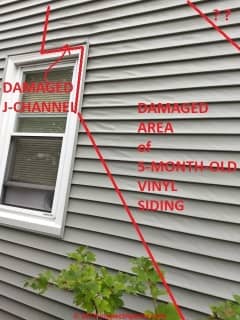 Question: - why aren't all the houses warped on the east side in my neighborhood?
Question: - why aren't all the houses warped on the east side in my neighborhood?
2018/08/19 CBS said:
A licensed contractor installed siding to my home in Michigan in March 5 months ago when it was cold and snowy.
They saw this damage is from sun reflecting from my neighbor's window and will not cover or replace the damage. They knew how close my neighbor's house was and what kind of window they have.
I asked about longevity and durability before closing the company and was assured it would do well in my location. Now they refuse to cover it and call this common.
If this is common they should have disclosed this and why aren't all the houses warped on the east side in my neighborhood? - Anonymous by web page posting and by private email
This vinyl siding damage Q&A were posted originally at VINYL SIDING BUCKLED WARPED where we outline all of the causes of buckling, warping, cracking or other vinyl-siding failures and defects.
Reply: how to diagnose reflected-heat / reflected sunlight-damaged siding
I looked at your photo - shown here in edited form.
I'm not sure who your knowledgeable people are nor what is their actual expertise, now why Home Depot's expert told you that "this should not happen", but it is absolutely the case that vinyl siding can be buckled or warped by heat, including reflected sunlight in some circumstances, though it's uncommon.
- Map the pattern of damage against the position, shape, distance of - to nearby windows vs. position of the sun. The pattern of damage in your siding is consisted with reflected heat but I need to see more perspective, more distance, the offending window, the distance to it, etc.
- Note damage to J-channel not just siding: The fact that the J-channel around the upper right corner of your home's window is also warped is strong support for the reflected heat cause.
It's not likely that just one portion of one length of vinyl J-channel over the window would deform exactly aligned with the siding deformation if the problem were defective product responding to sunlight. - Measure distance to the heat source & variations in reflectivity:
To confirm heat reflected from a neighbors window as the source of damage to your siding you or we need a bit more information including photos showing the relationship of the reflecting window to your house wall.
I'd want to see the location, size, shape of the reflecting window and I'd want us to be able to match it to the pattern of buckling or warping of your siding.
Here is a second photo from the reader that shows the posited direction of reflected solar radiation that appears to explain the oil-canned vinyl siding damage.
- Confirm position of the sun vis-a-vis the reflecting window or other heat source: We also need to document the position of the sun during the day versus these observations.
Report on these angles: the solar height (altitude), solar azimuth, and both window and siding angle with respect to the direction of sunlight and the direction of reflected or radiated heat onto the siding. - Confirm damage pattern and reflected heat source pattern and shape: Usually we can make a convincing argument by observing actual reflected light or heat is the damage source by matching a pattern of visible reflected light or measurable reflected heat
or even by drawing simple lines of potential reflections onto a sketch of the two buildings, the source window and the area of damage. - Confirm that same damage doesn't occur outside of the reflected-heat area: It's also compelling if we know that the damage appears only on one side of the home, perhaps in one location that matches the details I've outlined.
- Other sources of warping vinyl siding include defective product, exposure to chemicals or solvents, UV light exposure damage, and -though this doesn't appear to be the case for your siding - mis-nailing.
Perhaps you can provide some of those details, as I'm sure you agree that it would be even more disappointing to try to take any action only later to find that we mis-diagnosed the cause.
I'm not sure what your neighbor could do to prevent this problem other than perhaps installing an awning (maybe at your expense) over the offending window. Shading the buckled area of your home to avoid new damage is not likely to be practical.
Damaged areas of siding can be replaced. To minimize problems of color mis-match between the existing and replacement vinyl siding, and considering that your siding is less than six months old, it would make sense to take this step soon.
See VINYL SIDING INSTALLATION PROCEDURES for suggestions and tools that are used to remove and replace vinyl siding in the middle of a wall.
Watch out: Do not replace the damaged siding before you are confident that you have a correct understanding of the cause. We don't want an un-corrected cause to damage the replacement material as well.
Reader Comments: diagnosing why there is rippled odd looking vinyl siding - traced to reflected sun-heat
The picture with the dryer vent below the window that you show in this article was caused by the reflection of the sun off the window. I would put $$$ on it. - Jim Hilt 9/11/2011
There's a good chance the rippled effect on the siding was caused my improper dryer vent installation and hot dryer air is leaking behind the siding. - Anonymous 9/15/2012
Reply:
Thanks for the guesses, Jim and Anonymous.
Jim:
Interesting in this case, you'll see that the rippled vinyl siding extends way below the opposing window - not in the immediately-obvious path of reflected heat from the window glass.
Anonymous:
We have expanded our discussion of the rippled vinyl siding effect to explain the difference between obvious heat damage from a barbecue grill and the odd rippling in our photo discussed above
The vent you saw is not for a hot air dryer, it's an air intake for a fireplace insert built into that chimney chase. But your guess is a good one in that there may be a more dangerous hot gas leak from the fireplace.
For that reason we recommended invasive inspection to check the chimney chase interior as well as the condition of the fireplace
For additional photographs and discussion of all types of sagged, torn, cut, broken, rippled, or otherwise damaged vinyl siding, take a look at these subtopics found in the article above, starting at VINYL SIDING BUCKLED WARPED
Reader Follow up / Comment: Vinyl Siding Rippling Caused by Sunlight & Heat Reflected from Nearby Windows
The picture with the dryer vent below the window was caused by the reflection of the sun off the window. I would put $$$ on it. - Jim Hilt 9/11/2011
... - you'll see that the rippled vinyl siding extends below the opposing window - not in the path of reflected heat from the window glass . - Ed.
On the contrary! As the sun rises in the sky, the reflected light and heat move downward on the wall. That softening pattern is exactly where it should be. When the window and adjacent wall are so close together (and always facing south and west), no breeze carries the hot air away.
Between the direct sun and the reflected sun, you get high temperatures on the surface, but it's rare to see damage from it, because usually airflow cools the surface off.
When you put them too close together like this (and again, oriented to the sun just-so), the pocket of dead air allows temps to get even higher and you see the damage shown. - Mike in Michigan 11/28/2012
Reply:
Thanks so much, Mike! We are so grateful for your very interesting explanation of our "mystery" rippled vinyl siding. Your analysis looks very reasonable & sound to me. Though I needed to see the careful reasoning in your comment, now I'm convinced.
Indeed this side of this home faces roughly South and the side of the facing chimney chase was indeed, in some weather, a hot, dead-air space.
We will look for other examples of the case you describe and would welcome photos of this vinyl siding damage type from other readers. (Use the CONTACT US link found at page top or bottom to send us email & photos)
We appreciate your taking the time to comment: working together we are smarter than anyone. - Daniel
Reader Question: buckled siding from reflection from self-cleaning windows?
(Sept 26, 2014) Bill said:
Has anyone heard of vinyl siding buckling due to reflecting from self cleaning windows
Reply:
Moderator said:
Yes Bill, we have reported on buckling vinyl siding from heat reflected from nearby windows. The fact that windows are "self cleaning" is not a gating consideration it's reflection of heat and sunlight off of glass.
In the article above in the section titled "Vinyl Siding Deformation Caused by Other Hazards: heat leaks, chemical spills, reflected sunlight & heat from nearby surfaces, or unknown" you can read about this phenomenon and see photo examples of its occurrence.
Anonymous [apparently a window vendor - Ed] said:
The number one dissatisfaction with vinyl siding is the warping and buckling. The reason for this 99.9% of the time is installation.
Vinyl siding is a great product overall and now there is a guaranteed fix for the warping and buckling that occurs during temperature changes.
The Glide-Lock Siding Hanger can be used with over 96% of all vinyl sidings, easy to use, low cost and proven effective. In fact warping and buckling is covered under the lifetime Written Warranty.
(Feb 12, 2015) Richard Brow said:
I have the same issue with Deformation of siding. According to CertainTeed originally it was from the window reflection. After that it was the roof.
Then the skylight.
CertainTeed came out and replace a small area (2 months after it was installed)and did not last. They can't tell me what caused it and refuse to repair. No lifetime warranty just lip service.
Reply:
Richard,
If you like, find our email at the CONTACT link at page bottom and send me some photos for further inspection and comment.
Buckled Vinyl Siding Research: Effects of Sunlight & Radiated / Reflected Heat on Vinyl Siding
Above: photo of heat-damaged vinyl siding, provided courtesy Kathleen Hess Kosa cited bellow.
- Carson, Alan, to Daniel Friedman, "... it’s the reflected and concentrated sunlight I’m thinking of when the outer pane doubled glazed windows deflects to form a magnifying glass." private email, 2016/03/31.
Alan included a photo by Don Lovering showing magnifying-glass-like sunlight patterns on the surface of a vinyl sided building with severely-buckled siding - shown at the top of this page. - Cardinal IG, VINYL SIDING DISTORTION [PDF] (2016) retrieved 2018/08/19, original source: https://www.cardinalcorp.com/source/pdf/tsb/ig/IG14_01-2016.pdf
Good luck trying to find the company's contact information and mailing address on their website. The adress may be: Cardinal IG Co, 50 Elmwood Ave, Mountain Top, PA 18707 USA - Ed.
This document refers to Hart (2011) cited below.
Excerpts:
Instances of vinyl siding distortion have been reported along with questions related to how it occurs. This bulletin provides information related to a study and analysis conducted by Cardinal Glass Industries along with general recommendations on how to avoid vinyl siding distortion.
Vinyl siding distortion can occur when radiated or reflected solar energy from various sources combine with ambient temperature and direct sunlight exposure to cause visible distortion of vinyl siding.
According to a recent LBNL report, the heat deflection temperature of vinyl siding ranges from 142 °F - 192 °F with an average distortion temperature of 166 °F1 .
While the occurrence of vinyl siding distortion cannot be reliably predicted, awareness of its contributing factors may help to avoid it. - Graham, Heather, "The Heat is On" retrieved 2018/08/19, original source: http://www.csef.colostate.edu/2014_Abstracts/Graham_Heather.pdf
abstract of a science fair project, text excerpts quoted below:
My science fair project was to test seven types of siding materials to determine which material could withstand fire. The seven types of siding were tested at a temperature of 522 to 534 degrees for 30 seconds.
I used an infrared temperature sensor to help read the temperature on the siding materials I was testing. ... There was a lot of heat that transferred through to the back of the siding, but without failure of the siding.
The heat that transferred to the back would start a fire on the structure of the house. The vinyl siding was a complete catastrophic failure testing at a temperature of 522 degrees. - Hart, Robert, Charlie Curcija, Dariush Arasteh, Howdy Goudey, Christian Kohler, and Stephen Selkowitz. RESEARCH NEEDS: GLASS SOLAR REFLECTANCE AND VINYL SIDING [PDF] (2011) retrieved 2018/08/19, original source: https://pubarchive.lbl.gov/islandora/object/ir%3A156996/datastream/PDF/view
Corresponding author: R. Hart, Berkeley Lab, U.S. Department of Energy National Laboratory Managed by the University of California, Email: rghart@lbl.gov, phone: 510.486.4244
Abstract:
The subject of glass solar reflectance and its contribution to permanent vinyl siding distortion has not been extensively studied, and some phenomena are not yet well understood. This white paper presents what is known regarding the issue and identifies where more research is needed.
Three primary topics are discussed: environmental factors that control the transfer of heat to and from the siding surface; vinyl siding properties that may affect heat build-up and permanent distortion; and factors that determine the properties of reflected solar radiation from glass surfaces, including insulating window glass.
Further research is needed to fully characterize the conditions associated with siding distortion, the scope of the problem, physical properties of vinyl siding, insulating window glass reflection characteristics, and possible mitigation or prevention strategies. - Hess-Kosa, Kathleen BUILDING MATERIALS: Product Emission and Combustion Health Hazards, [Book Review] Kathleen Hess-Kosa, (available February 27, 2017), ISBN 9781498714938, Hardcover reference text, 334 pages, available from CRC Press, Taylor & Francis Group.
[Purchase this book at CRC PRESS] - Isner, James D., and James W. Summers. "The appearance retention properties of poly (vinyl chloride) compounds during weathering." Polymer Engineering & Science 18, no. 11 (1978): 905-907.
- Leichtfried, Franz. "Siding system." U.S. Patent Application 10/230,231, filed July 17, 2003.
Patent abstract excerpt:
Another drawback of prior art siding systems is that, when exposed to strong sunlight and high outdoor temperatures, vinyl siding can become so heated as to become warped and buckled.
Warped vinyl siding may no longer form an effective barrier against rain and moisture and has diminished aesthetic qualities. - Long, Alan J., and Cotton K. Randall. Wildfire risk assessment guide for homeowners in the southern United States. School of Forest Resources and Conservation, University of Florida, 2004.
Excerpt:
the vinyl siding around the windows and the vinyl soffit vents were damaged, - Progressive Foam, INSULATED VINYL SIDING GUIDE [PDF] Progressive Foam Headquarters, 6753 Chestnut Ridge Rd. Beach City, OH 44608 USA, Tel: 800-860-3626, Email: info@progressivefoam.com retrieved 2018/08/19, original source: https://www.progressivefoam.com/
- Rabinovitch, Elvira B. "Dimensional stability of exterior building products." Journal of Vinyl Technology 10, no. 1 (1988): 14-20.
Abstract:
Dimensional stability problems such as warpage, bowing and other changes in shape and size may occur when exterior building products (siding, windows) are heated by the sun. This paper describes the effects of material properties such as coefficient of thermal expansion, heat distortion temperature, modulus, and heat build-up, caused by the sun, on dimensional stability of the exterior building products. - Rabinovitch, Elvira B. "Factors affecting dimensional stability of exterior vinyl products." In Makromolekulare Chemie. Macromolecular Symposia, vol. 29, no. 1, pp. 241-251. Hüthig & Wepf Verlag, 1989.
Abstract:
Dimensional stability problems such as warpage, bowing, buckling and other changes in shape and size may occur when exterior building products (siding, windows) are heated by the sun.
This paper describes the effects of material properties such as coefficient of thermal expansion, heat deflection temperature and heat buildup, caused by the sun, on dimensional stability of exterior building products.
This paper also discusses the effect of profile design, such as thickness and width, on dimensional performance. - Summers, James W., and Elvira B. Rabinovitch. Weather ability of vinyl and other plastics. William Andrew Publishing, Norwich, 1999.
- Summers, James W. "Formulations for vinyl house siding: History, present, future." Journal of Vinyl Technology 5, no. 2 (1983): 43-46.
Abstract:
In the early 1960s, vinyl house siding was first commercialized. The colors were pastels and included white, green, yellow, and gray.
All siding tended to bleach and fade (oxidize) to an extent where medium and dark colors were unacceptable, since the fading is more noticeable in deeper colors. All the early siding was made from cubes on single‐screw extruders.
Powder compounds were first introduced in the late 1960s, as was twin‐screw extrusion. At the same time higher processing temperatures were used on, both twin‐ and single‐screw extruders. That led to a well‐fused and tougher product. Formulation changes reduced bleaching and fading and permitted such medium‐depth colors as tan, gold, beige, blue, and olive.
This technology allowed rapid growth in the vinyl siding industry in the late 1970s. Surface distortion (oil canning) was recognized as a potential problem with the early gray color and recognized as a major problem with dark colors; it was resolved only by understanding the fundamental principles involved.
Another major problem was the fading in dark colors and here again extensive research into the principles of weathering led to the use of a thin, highly weatherable capping as a cost‐effective solution.
For the future, many technical developments can be expected in this rapidly growing market. However, judging by the occasional withdrawal of a formulation from the market, and by an occasional homeowner complaint, present performance in several properties must be judged as just adequate.
For this market to continue its rapid growth, future performance should be better than today's. This can be accomplished without hurting economics by careful understanding of all parameters involved. Formulation changes will allow better performance.
Standards must be raised to control product performance, especially surface distortion and color stability in darker colors, and to insure retention of physical properties after long‐term weathering. - Tsongas, George A. "Cautionary Case Studies: Damage in Multifamily Housing Walls With Vinyl Siding." ASHRAE Journal 59, no. 7 (2017): 44.
- Walkinshaw, Stew, Dave Schroeder, and S. Hvenegaard. "Evaluating effectiveness of FireSmartTM priority zones on structure protection." FPInnovations Wildfire Operations Research, Hinton, Alberta (2012).
Contact: Ray Ault, Research Leader, Wildifire Operations, Tel: 780-817-1840, Email: ray.ault@fpinnovations.ca
Excerpt:
Cabin B sustained radiant heat damage to the vinyl siding on the side facing the oncoming fire. - Weaver, Leonard W. "Weatherability of rigid vinyl siding." Journal of Vinyl Technology 1, no. 2 (1979): 72-75.
Reader Comments, Questions & Answers About The Article Above
Below you will find questions and answers previously posted on this page at its page bottom reader comment box.
Reader Q&A - also see RECOMMENDED ARTICLES & FAQs
Question:
I discovered several buckled vinyl panels which someone said is due to heat. The exact panels are outside...however my inside electrical breaker box is exactly opposite. I became alarmed and checked my inside box. It is totally fine and clean, no evidence of overheating or burn. I first noticed this several months ago. Do you think I have some kind of electrical problem causing these few panels to buckle. - Sue 2017/05
Moderator reply:
With no overheating in the interior electrical box nor at wires leadign to it, it sounds as if its only possible contribution to siding buckling would be if a difference in wall insulation in that location affected wall temperatures.
Other causes are more-likely.
Please see the causes of vinyl siding buckling above and also at the topic home: VINYL SIDING BUCKLED WARPED
On 2018-06-21 - by (mod) -
RKD
I can't see your top rail nor home from here in Mexico, so I can but guess:
Look for
- a failed connection between rail and home, or rot, or mechanical damage, or insect attack
- movement or sinking or damage to the posts supporting whatever deck or platform is supporting the railing
Watch out: a loose railing itself is dangerous - someone can fall, and in addition whatever is causing the movement could be a clue that something else dangerous or important is happening to the structure below the rail.
On 2018-06-21 by RKD
What could be causing my top rail to pull away from my manufactured home
On 2017-09-24 - by (mod) -
Anon,
One thing to consider is that if you've painted the siding, depending on exactly what paint you were using, solvents in the paint could cause the siding to buckle and deform.
On 2017-09-24 by Anonymous
I have an issue with vinyl siding i installed 3 times in the same area in 3 weeks on the front of my house first and second floor and each time it has curled and looks like its melted it looks the same as the pictures of the the melted siding from sunlight in pennsylvania could it be a manufacturing issue we also had painted the siding
On 2017-07-07 by Sandy Anderson
Am I responsible to replace a neighbors siding if they declare that the damage is the result of a reflection off a replacement window?
On 2017-07-01 - by (mod) -
Matk
I'd like to see the condition of your siding and chimney chase - you can use the page top or bottom CONTACT link to send images.
About abandoning the outside air for your fireplace, I'd recommend keeping that working. A wood burning fire requires quite a lot of combustion air; if you abandon the outside air source the fireplace may not work safely when the fireplace doors are shut and when they're open it will draw air from the occupied space, significantly increasing the building's heating cost. For a gas fireplace, eliminating combustion air risks a fatal carbon monoxide hazard.
On 2017-07-01 by Matk Zinn
I have the exact same problem.. chimney chase with long narrow window less than a foot away at a right angle to the chimney chase vinyl siding, south side of the house. I opened up the chase and found everything still looked new after 25 years, no signs of any fireplace heat escape issues.
Listed fireplace, double wall stainless steel chimney, all installed properly with proper clearances. I found some water damage from a leaking fireplace outside air vent, which I am in the process of repairing. I am not re-installing the outside air vent. Most data shows they are not needed.
...
Continue reading at VINYL SIDING BUCKLED RIPPLED COMBINED EFFECTS? or select a topic from the closely-related articles below, or see the complete ARTICLE INDEX.
Or see these
Recommended Articles
- SIDING VINYL - home
- THERMAL EXPANSION of MATERIALS for a table of CLTE values for common building materials
- VINYL SIDING INSPECTION & REPAIR
- VINYL SIDING INSTALLATION
- VINYL SIDING BUCKLED WARPED
Suggested citation for this web page
VINYL SIDING DEFORMED by SUNLIGHT at InspectApedia.com - online encyclopedia of building & environmental inspection, testing, diagnosis, repair, & problem prevention advice.
Or see this
INDEX to RELATED ARTICLES: ARTICLE INDEX to BUILDING SIDING
Or use the SEARCH BOX found below to Ask a Question or Search InspectApedia
Ask a Question or Search InspectApedia
Try the search box just below, or if you prefer, post a question or comment in the Comments box below and we will respond promptly.
Search the InspectApedia website
Note: appearance of your Comment below may be delayed: if your comment contains an image, photograph, web link, or text that looks to the software as if it might be a web link, your posting will appear after it has been approved by a moderator. Apologies for the delay.
Only one image can be added per comment but you can post as many comments, and therefore images, as you like.
You will not receive a notification when a response to your question has been posted.
Please bookmark this page to make it easy for you to check back for our response.
Our Comment Box is provided by Countable Web Productions countable.ca
Citations & References
In addition to any citations in the article above, a full list is available on request.
- Bob Fankhauser <blueboxconst@hevanet.com>, 503 206 9824 Cell, a retired engineer / professional handyman and Habitat for Humanity volunteer who offered comments, suggestions, additions for vinyl CLTE (Coefficient of Linear Thermal Expansion), CPVC, PVC, cellular PVC, and vinyl (25 Feb 20-16) as well as helpful discussion concerning the wide variation in coefficients of expansion of materials given by various sources.
- Eric Galow, Galow Homes, Lagrangeville, NY. Mr. Galow can be reached by email: ericgalow@gmail.com or by telephone: 914-474-6613. Mr. Galow specializes in residential construction including both new homes and repairs, renovations, and additions. [ About Hurricane Katrina and building products, personal communication, 8/27/2013]
- Steve Bliss's Building Advisor at buildingadvisor.com helps homeowners & contractors plan & complete successful building & remodeling projects: buying land, site work, building design, cost estimating, materials & components, & project management through complete construction. Email: info@buildingadvisor.com
Steven Bliss served as editorial director and co-publisher of The Journal of Light Construction for 16 years and previously as building technology editor for Progressive Builder and Solar Age magazines. He worked in the building trades as a carpenter and design/build contractor for more than ten years and holds a masters degree from the Harvard Graduate School of Education. Excerpts from his recent book, Best Practices Guide to Residential Construction, Wiley (November 18, 2005) ISBN-10: 0471648361, ISBN-13: 978-0471648369, appear throughout this website, with permission and courtesy of Wiley & Sons. Best Practices Guide is available from the publisher, J. Wiley & Sons, and also at Amazon.com - Mark Cramer Inspection Services Mark Cramer, Tampa Florida, Mr. Cramer is a past president of ASHI, the American Society of Home Inspectors and is a Florida home inspector and home inspection educator. Mr. Cramer serves on the ASHI Home Inspection Standards. Contact Mark Cramer at: 727-595-4211 mark@BestTampaInspector.com
- John Cranor [Website: /www.house-whisperer.com ] is an ASHI member and a home inspector (The House Whisperer) is located in Glen Allen, VA 23060. He is also a contributor to InspectApedia.com in several technical areas such as plumbing and appliances (dryer vents). Contact Mr. Cranor at 804-873-8534 or by Email: johncranor@verizon.net
- In addition to citations & references found in this article, see the research citations given at the end of the related articles found at our suggested
CONTINUE READING or RECOMMENDED ARTICLES.
- Carson, Dunlop & Associates Ltd., 120 Carlton Street Suite 407, Toronto ON M5A 4K2. Tel: (416) 964-9415 1-800-268-7070 Email: info@carsondunlop.com. Alan Carson is a past president of ASHI, the American Society of Home Inspectors.
Thanks to Alan Carson and Bob Dunlop, for permission for InspectAPedia to use text excerpts from The HOME REFERENCE BOOK - the Encyclopedia of Homes and to use illustrations from The ILLUSTRATED HOME .
Carson Dunlop Associates provides extensive home inspection education and report writing material. In gratitude we provide links to tsome Carson Dunlop Associates products and services.


